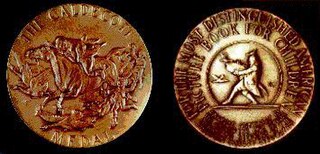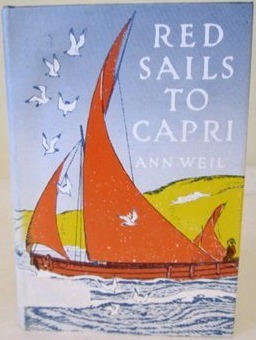Related Research Articles

The John Newbery Medal, frequently shortened to the Newbery, is a literary award given by the Association for Library Service to Children (ALSC), a division of the American Library Association (ALA), to the author of "the most distinguished contributions to American literature for children". The Newbery and the Caldecott Medal are considered the two most prestigious awards for children's literature in the United States. Books selected are widely carried by bookstores and libraries, the authors are interviewed on television, and master's theses and doctoral dissertations are written on them. Named for John Newbery, an 18th-century English publisher of juvenile books, the winner of the Newbery is selected at the ALA's Midwinter Conference by a fifteen-person committee. The Newbery was proposed by Frederic G. Melcher in 1921, making it the first children's book award in the world. The physical bronze medal was designed by Rene Paul Chambellan and is given to the winning author at the next ALA annual conference. Since its founding there have been several changes to the composition of the selection committee, while the physical medal remains the same.

The Randolph Caldecott Medal, frequently shortened to just the Caldecott, annually recognizes the preceding year's "most distinguished American picture book for children". It is awarded to the illustrator by the Association for Library Service to Children (ALSC), a division of the American Library Association (ALA). The Caldecott and Newbery Medals are considered the most prestigious American children's book awards. Besides the Caldecott Medal, the committee awards a variable number of citations to runners-up they deem worthy, called the Caldecott Honor or Caldecott Honor Books.
The Michael L. Printz Award is an American Library Association literary award that annually recognizes the "best book written for teens, based entirely on its literary merit". It is sponsored by Booklist magazine; administered by the ALA's young-adult division, the Young Adult Library Services Association (YALSA); and named for the Topeka, Kansas, school librarian Mike Printz, a long-time active member of YALSA. Up to four worthy runners-up may be designated Honor Books and three or four have been named every year.
The Wonder-Smith and His Son: A Tale from the Golden Childhood of the World is a children's book by Ella Young. It is a collection of fourteen stories about Gubbaun Saor, the legendary Irish smith and architect. The book, illustrated by Boris Artzybasheff, was first published in 1927 and was a Newbery Honor recipient in 1928.

A Daughter of the Seine: The Life of Madame Roland is a biography written for children by Jeanette Eaton. It recounts the life story of Marie-Jeanne Roland de la Platière, an influential figure in the French Revolution. Born in relative obscurity, she became a prominent Girondist and was executed in one of Robespierre's purges. The biography was first published in 1929 and was a Newbery Honor recipient in 1930.

Meggy MacIntosh is a children's historical novel by Elizabeth Janet Gray. Beginning in 1775, it follows the story of a young Scottish orphan who becomes involved with the American revolutionary cause in North Carolina despite her attachment to Flora MacDonald, a loyalist. The novel, illustrated by Marguerite de Angeli, was first published in 1930 and was a Newbery Honor recipient in 1931.
Ood-Le-Uk the Wanderer is a children's novel by Alice Alison Lide and Margaret Alison Johansen, illustrated by Raymond Lufkin and published by Little, Brown & Co., in 1930. It tells the story of an Alaskan Eskimo who crosses the Bering Strait, has many adventures and returns to establish trade between his people and the Siberian tribesmen. The novel was first published in 1930 and was a runner-up for the Newbery Medal in 1931.
Boy of the South Seas is a children's novel by Eunice Tietjens. It tells the story of Teiki of the Marquesas Islands who, after accidentally stowing away on a visiting ship, makes a new life on the island of Moorea. The book is illustrated by Myrtle Sheldon. It was first published in 1931 and was a Newbery Honor recipient in 1932.
Swift Rivers is a children's historical novel by Cornelia Meigs. Set initially in 1835 in Minnesota, it is a story of the early days of the logging industry, when logs were floated down the Mississippi to St. Louis. The novel, illustrated by Forrest W. Orr, was first published in 1931 and was a Newbery Honor recipient in 1933.
The Railroad to Freedom: A Story of the Civil War is a children's book by Hildegarde Swift. It is a fictionalized biography of Araminta Ross telling of her life in slavery and her work on the Underground Railroad. The book, illustrated by James Daugherty, was first published in 1932 and was a Newbery Honor recipient in 1933.
Whistlers' Van is a children's novel by Idwal Jones. Set in rural Wales shortly after World War I, it tells the story of a young farmboy, Gwilyn, who spends one summer traveling with the gypsies. The novel, illustrated by Zhenya Gay, was first published in 1936 and was a Newbery Honor recipient in 1937.
Winterbound is a children's novel by Margery Williams. It is a family story set in a Connecticut farmhouse during the Great Depression. Nineteen-year-old Kay and sixteen-year-old Garry are in charge of the house and their younger siblings while their parents are away during the winter. The novel, illustrated by Kate Seredy, was first published in 1936 and was a Newbery Honor recipient in 1937.
Bright Island is a children's novel by Mabel Robinson. It tells the story of Thankful Curtis, who, having grown up on a small island off the coast of Maine, reluctantly agrees to attend school on the mainland for her senior year. The novel, illustrated by Lynd Ward, was first published in 1937 and was a Newbery Honor recipient in 1938.
Nino is a children's novel written and illustrated by Valenti Angelo. It tells the story of Nino's childhood in a small Italian village at the turn of the century. First published in 1938, it was a Newbery Honor recipient in 1939.
Runner of the Mountain Tops: The Life of Louis Agassiz is a children's biography of Louis Agassiz, the nineteenth-century paleontologist and natural scientist, by Mabel Robinson. It tells his life story from his boyhood in Switzerland to his professorship at Harvard. Illustrated by Lynd Ward, the biography was first published in 1939 and was a Newbery Honor recipient in 1940.

Have You Seen Tom Thumb? is a biography of General Tom Thumb written for children by Mabel Leigh Hunt. It tells the story of Charles Sherwood Stratton, a charming and humorous dwarf who traveled all over the world with the showman P. T. Barnum. The book, illustrated by Fritz Eichenberg, was first published in 1942 and was a Newbery Honor recipient in 1943.

Li Lun, Lad of Courage is a children's novel by Carolyn Treffinger. Set on an island off the coast of China, it tells the story of a boy who tries to survive and grow rice on a barren mountain after being banished from his village. The novel, illustrated by Kurt Wiese, was first published in 1947 and was a Newbery Honor recipient in 1948.

The Quaint and Curious Quest of Johnny Longfoot is a children's comic fantasy novel by Catherine Besterman. Based on a Polish folktale, it tells the story of a shoe king's son who outwits guard dogs and a bear and is sent on a quest for gold and seven-league boots by a cat. The novel, illustrated by Warren Chappell, was first published in 1947 and was a Newbery Honor recipient in 1948.

Story of the Negro by Arna Bontemps is a children's history book published by Knopf in 1948. It was the first African-American authored book to receive a Newbery Honor.

Red Sails to Capri is a children's historical novel by Ann Weil. It tells the story of the rediscovery of Capri's Blue Grotto in 1826. The novel, illustrated by C. B. Falls, was first published in 1952 and was a Newbery Honor recipient in 1953.